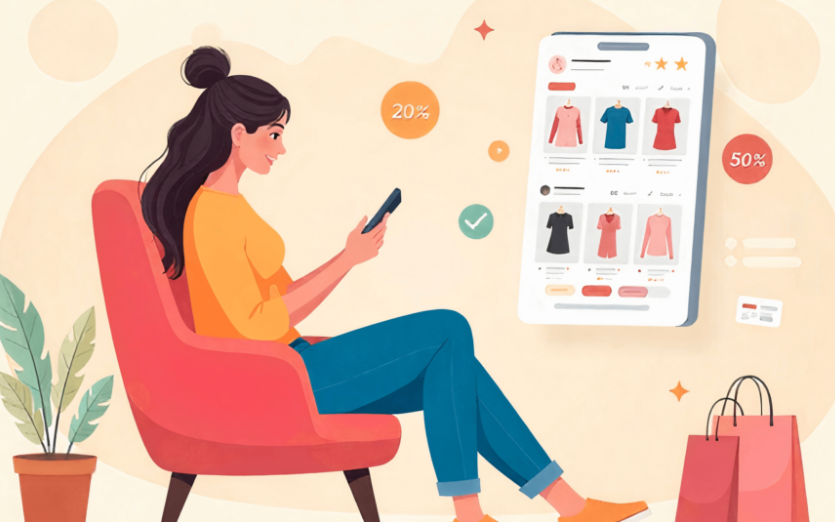
Over 70% of online shopping is done on smartphones. Therefore, if your website is not mobile-friendly, you will undoubtedly lose customers. Therefore, it is essential to optimize your online store for mobile devices. When you optimise Shopify store, it ensures:
Improved loading speeds Easier navigation
Smoother checkout process
resulting in increased sales The contentment of clients Therefore, in today’s article, we will offer you practical Mobile Shopify tips to make your Shopify store more mobile-friendly, including responsive design and simplified payment options.
Tips to Optimize a Shopify Store for Mobile
Consider someone shopping for a new pair of sneakers online.They’re excited but quickly frustrated because the website is slow, hard to navigate and images are blurry. This experience is common for mobile users, who are repelled by such issues.
It’s the reason to necessarily optimize your Shopify store. Here are Top 10 Mobile Shopify tips:
1. Choose a Mobile-Responsive Shopify Theme
The first step – towards excellent Shopify mobile optimisation – is choosing a mobile-responsive theme. This ensures your store looks good on all devices – from smartphones to desktops. Shopify’s theme store allows you to filter for mobile-optimised themes. Before launching, always test your theme on a mobile device. For example, if you sell clothes, a responsive theme ensures your product images resize beautifully on smaller screens.
2. Compress and Optimise Images
Large images slow down your site (especially on mobiles). Customers may leave a site that loads slowly. To reduce an image’s size without sacrificing its quality, use apps like TinyPNG or Shopify. To optimize Shopify store speed also, try lazy loading, where images load only when a user scrolls to them. For example for an online jewelry store, this helps keep the site quick and responsive with optimise Shopify store speed. Additionally, phones can display product images with high resolution.
3. Simplify Navigation
Mobile screens are very small, so simplify your navigation. A hamburger menu is required for Shopify mobile optimization to keep things organized and simple to access. Avoid deep menu structures customers should easily find what they need. Example – for a bookstore, a simple navigation structure allows users to quickly browse genres, bestsellers or new releases. Sticky headers will make it further easy by keeping key links accessible at all times.
4. Optimise Checkout for Mobile

For instance, if you run an electronics store, customers often want to quickly complete purchases. They do not wish to sign up or fill out long forms. A smooth checkout experience is important. Reduce the number of form fields, enable autofill and allow for very quick guest checkout. This improves conversion rates.
5. Increase Site Speed
A fast-loading site is essential for mobile users. Slow sites frustrate customers plus also hurt your SEO ranking. To optimize Shopify stores, use Shopify’s speed report and Google PageSpeed Insights to identify issues. A speedy site improves both the shopping experience and search engine visibility.
6. Use Mobile-Friendly Fonts and Button Sizes
Fonts should be easily readable on small screens. CTA Buttons should be large enough to tap without frustration. Keep body text at least 14px and ensure buttons are at least 44px by 44px. In other words, don’t make it difficult for customers to add their favorite products. For instance, in a beauty store, Shopify for mobile means making the “Add to Cart” button larger.
7. Test Everything on Real Devices
Lastly, always test your site on real Shopify for mobile devices. Browser resizing doesn’t always show the real mobile experience. Use tools like BrowserStack to test across multiple devices. A real-world testing ensures your store functions well on phones, from the product pages to checkout.
8. Leverage Mobile Analytics
Tracking on Shopify mobile apps how mobile users interact with your store is a critical aspect of e-commerce.For this you will need to use Google Analytics and Shopify reports to monitor bounce rates, exit rates and conversion rates on mobile devices. You can learn where mobile customers drop off during checkout with the help of this Shopify for mobile data and where improvements are required.
9. Optimise Popups and Banners
Popups can be intrusive on Shopify mobile apps. Instead of full-screen popups, use slide-in banners that appear after a few seconds. This is less disruptive and still grabs attention. For a fashion retailer, a timed banner offering a first-time shopper discount is more effective than a popup that blocks the entire screen.
10. Enable Accelerated Mobile Pages (AMP)
AMP (Accelerated Mobile Pages) can boost your mobile page load speed. Pages built with AMP load almost instantly. In this context, Shopify mobile optimization refers to improving mobile rankings and user experience. AMP can be integrated into your Shopify store with the help of apps like FireAMP. Say, for a toy store, this means kids and parents can quickly view and buy products without waiting for slow pages to load.
CTA:
Want to propel your sales through a mobile-friendly Shopify store? Then, hire Shopify developers to make strategic tweaks to your store. Expert benefits will quickly implement these tips and will step by step track the results. Start now, test the changes and watch your business grow!
